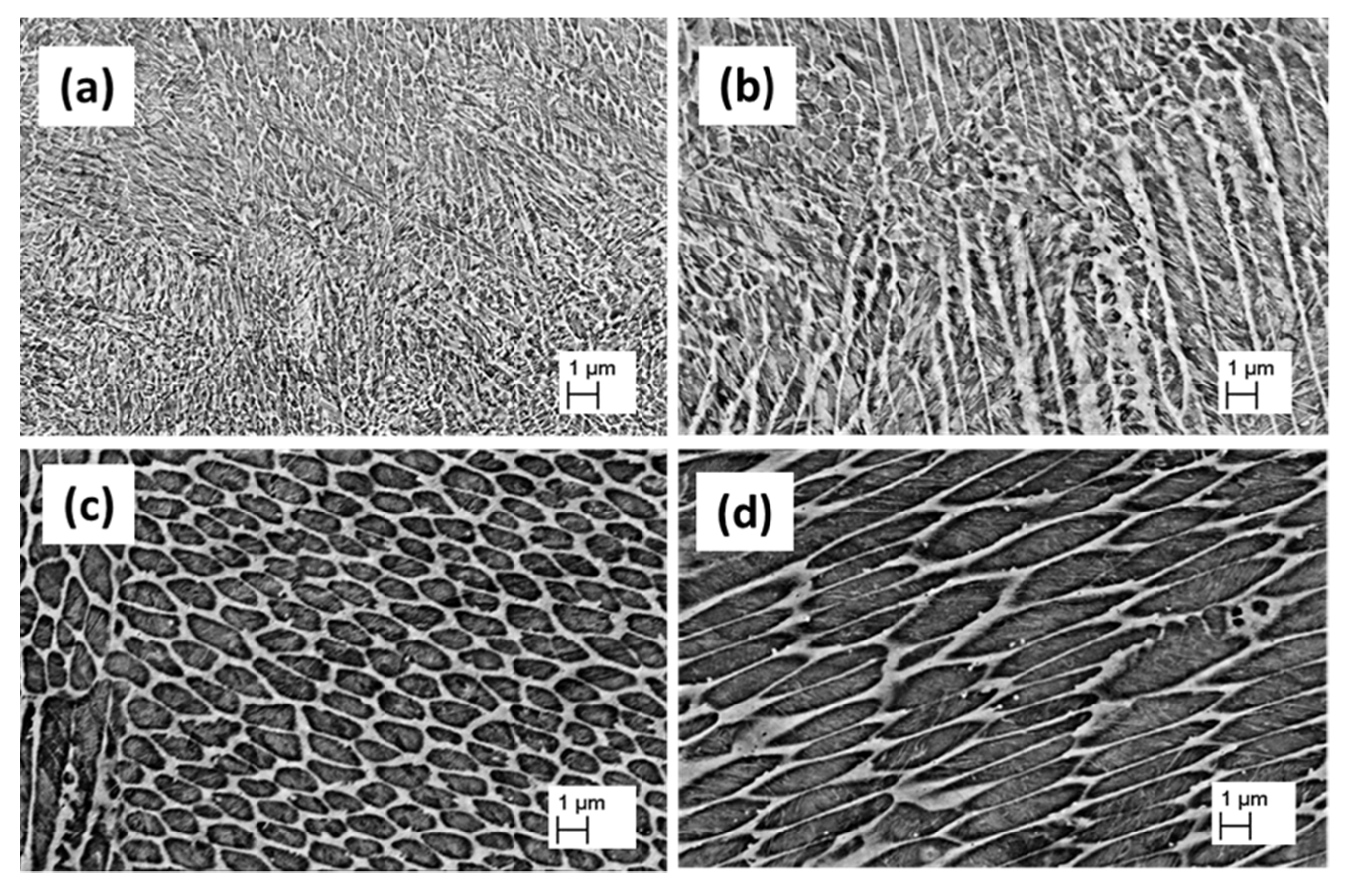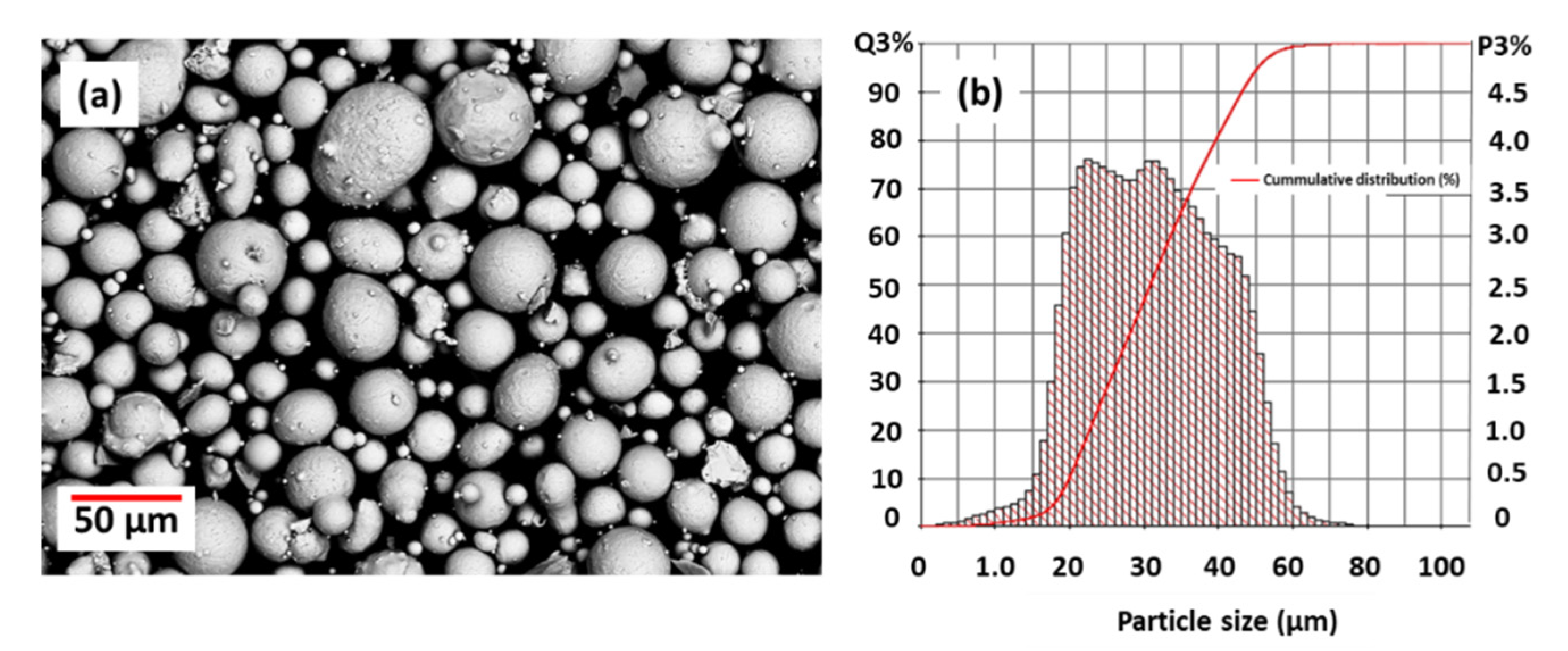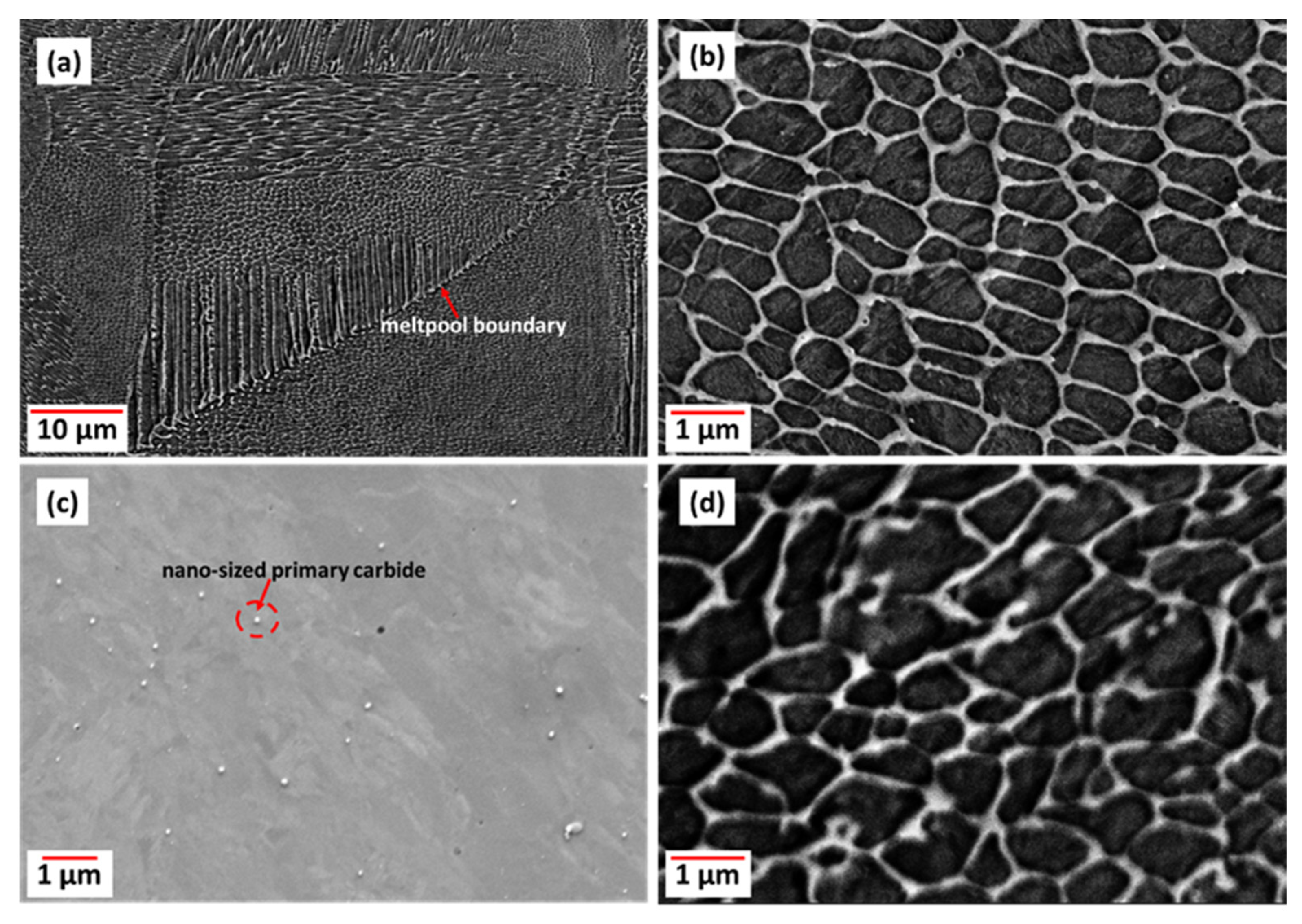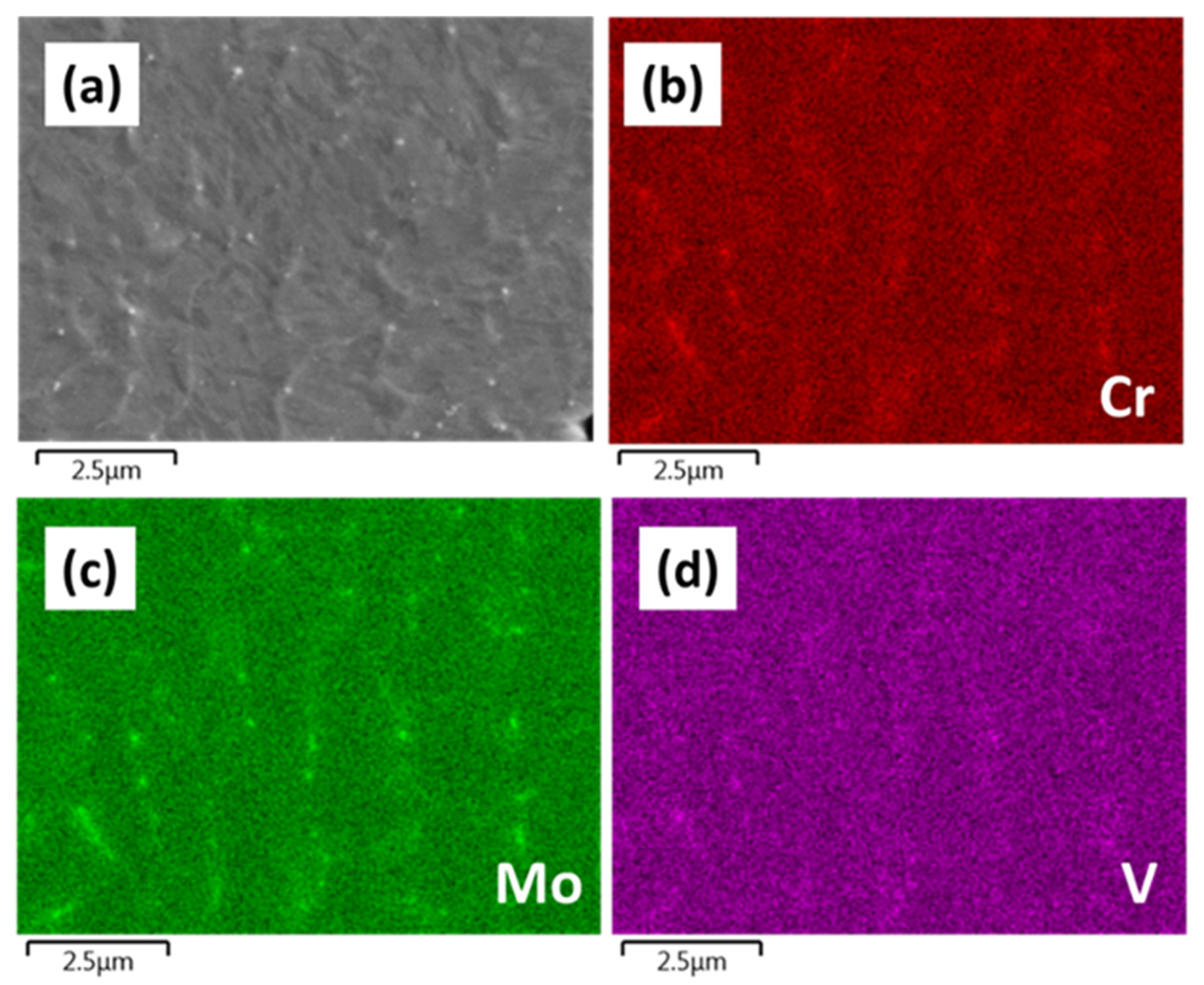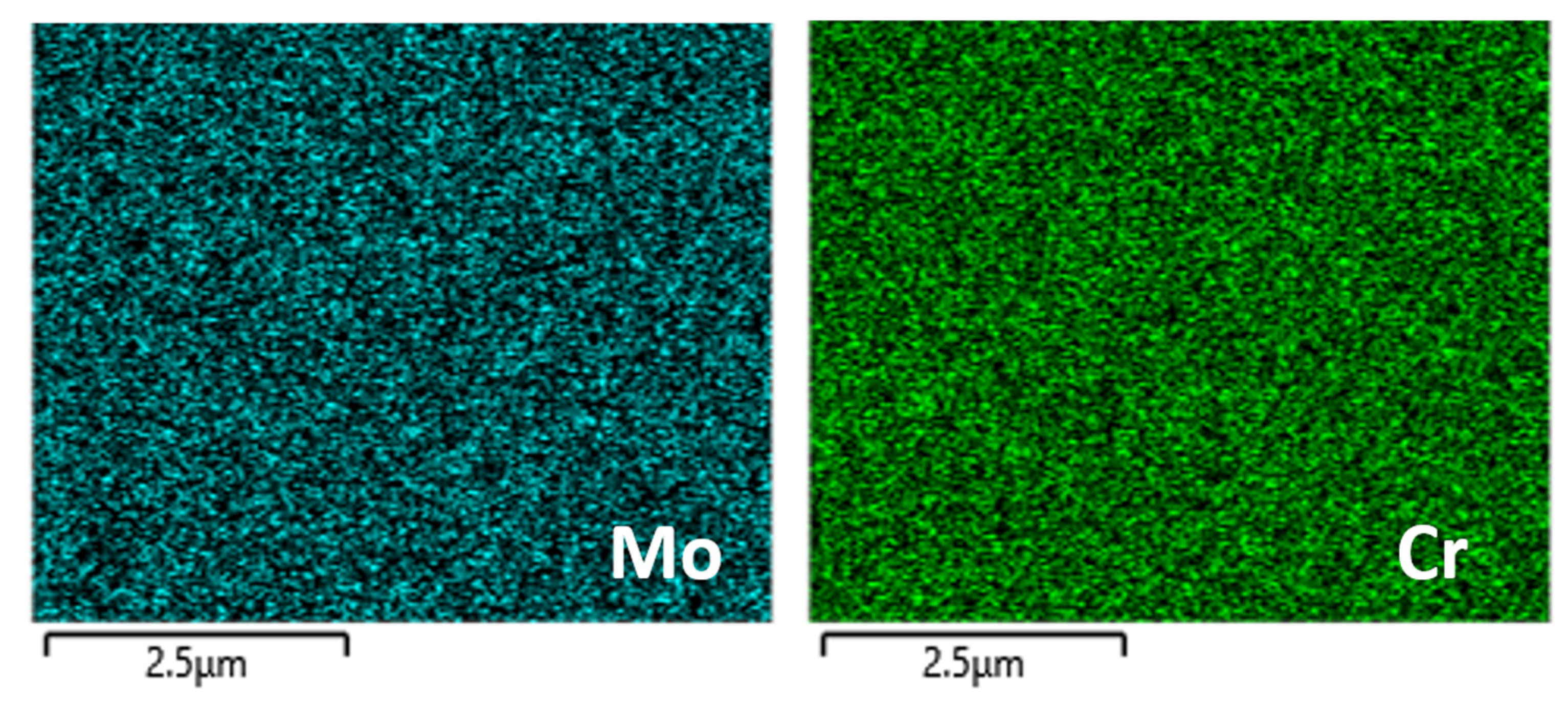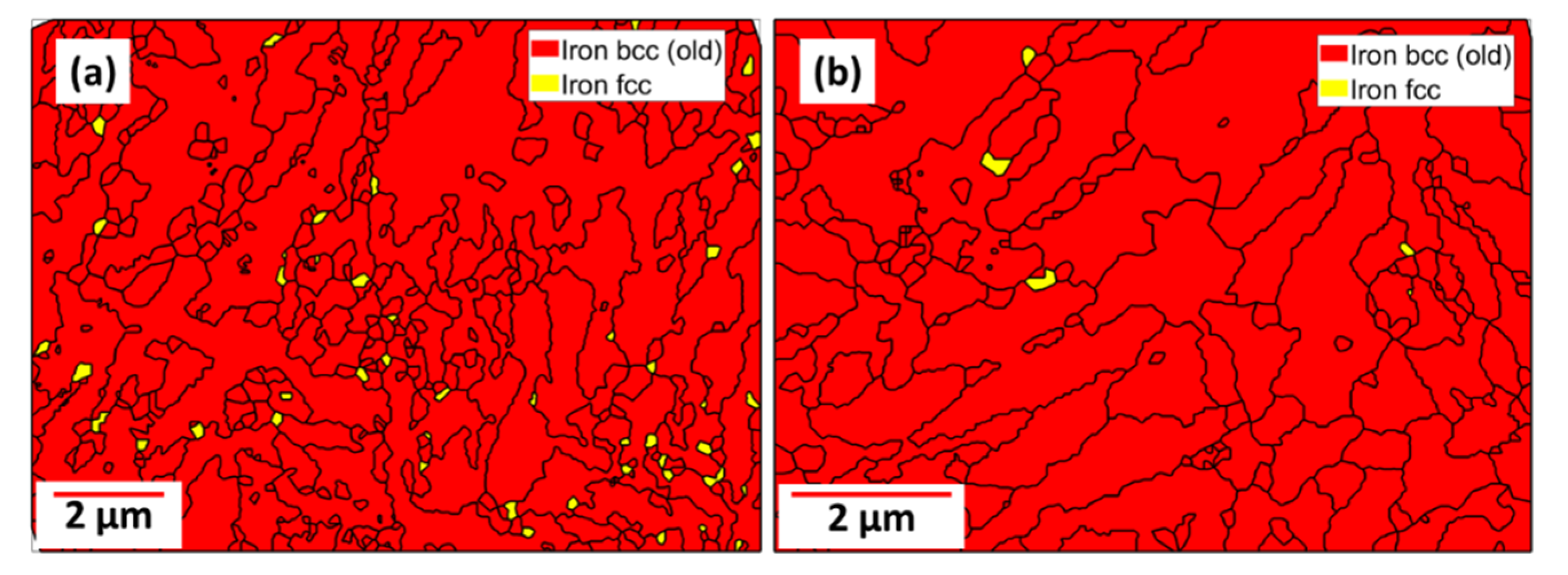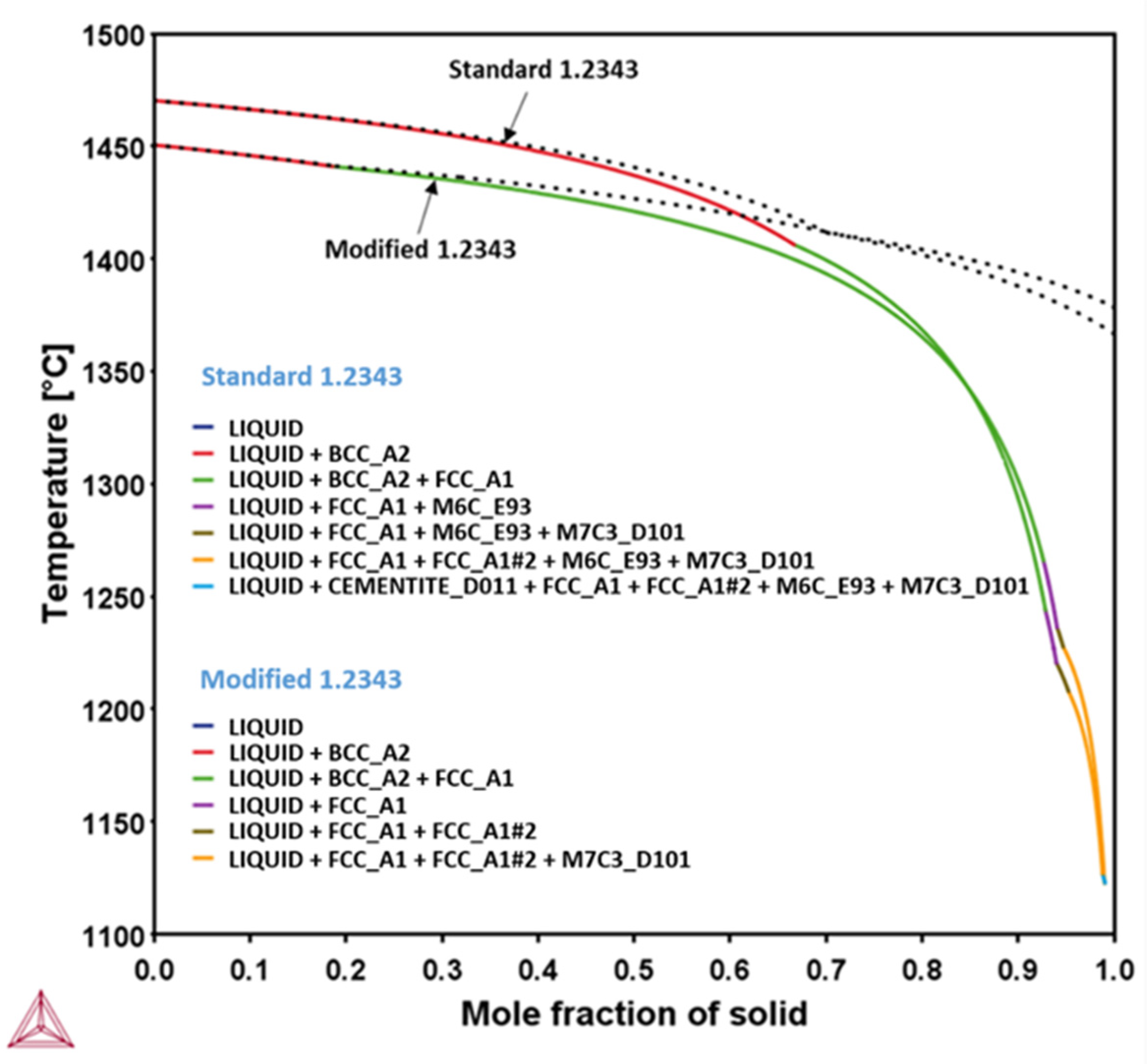3.2. Standard 1.2343-As-Built and Preheated LPBF-Test Cuboids
Test cuboids were printed with and without a preheated build plate. Since the microstructure of the powder particles consisted of martensite and some austenite (
Figure 1), two different cooling regimens (as-built and preheating) were employed to influence the microstructure. It is known that the cooling rate of the LPBF-process is higher than the cooling rate during atomizing.
The microstructure of the standard 1.2343 alloy, as shown by the SEM micrographs in
Figure 2a,b, revealed cellular dendritic structures both in the as-built and in the preheated condition (
Figure 2c,d). These cellular dendritic structures are typical sub-grain solidification microstructural features of hot work tool steels and have been reported by other authors to vary in size under both the LPBF and DED process conditions [
4,
17]. It appears that the preheat temperature of 500 °C did not significantly alter the cell structure as the microstructure under both conditions appeared similar. The studies by [
5,
18] equally observed that the different preheating temperatures did not alter the cellular microstructure. It was reported in [
19] that the cell sizes ranged between 0.5 and 1 µm in austenitic steel, which maintained their size, even with post heat treatment of 700 °C. In the preheated condition, as shown in
Figure 2c,d, small nano-sized carbides were visible within and on the boundaries of the (sub)-cells. Martensitic laths of the matrix crossed the cell boundaries. The carbide distribution appeared to be denser in the preheated condition. This is probably because the preheat treatment lowered the cooling rate, allowing more time for carbon diffusion, which influenced the distribution of carbon in the austenitic matrix so that carbides could grow. A higher cooling rate means more micro segregations at the cell boundaries.
3.6. Phase Characterization of LPBF-Test Cuboids
The EBSD maps generated from the standard 1.2343 HWTS are presented in
Figure 7 below in the as-built and in the preheated condition (500 °C). In the as-built condition shown in
Figure 7a, the microstructure was predominantly martensitic with about an 18% fraction of retained austenite. The predominant martensite fraction seen in the microstructure in
Figure 7 is consistent with tool steel microstructure from the LPBF built processes due to the high cooling rates [
4] The martensitic transformation takes place when the solidified austenitic cell colonies rapidly cool below the martensite start temperature [
17]. During the LPBF processes, as a result of the remelting of the underlying substrate layers typical with the process, some of the martensite may re-transform back into austenite, which upon rapid cooling, again below the martensite start, may not reach the martensite finish temperature and becomes stabilized by diffused carbon from the martensite, leaving a martensitic microstructure with some retained austenite [
21].
After the preheating of 500 °C, the retained austenite was significantly reduced from about 18% in the as-built condition (
Figure 7a) to about 1.1% (
Figure 7b). A similar behavior was observed by the authors [
5], who from the LPBF processing of a HWTS using base plate heating, reported a decrease in the amount of retained austenite with an increase in the preheating temperature. The almost complete transformation of austenite into martensite in AM is due to the repeatedly perfect cooling conditions, even in the remelting areas, in combination with the local chemical composition of the austenite. Martensite forms from the austenite in a diffusionless shear transformation under lattice expansion. If the residual strain in the austenitic lattice is too high, it may inhibit this transformation (even if the martensite finish is reachable). Therefore, if martensite formation is possible through the chemical composition combined with the necessary cooling rates in AM, martensite can form if a homogenous distribution of alloying elements is ensured because local differences may stabilize the austenite and lead to RA. The higher the segregation level in the material in certain locations, the steeper the expected gradient of segregating atoms close to these spots, most likely grain or cell boundaries, so that the austenitic lattice is stabilized. In the powder particles, micro segregations were observed at cell boundaries where the most RA was found (
Figure 1e,f). In the modified 1.2343, less segregation (
Figure 6) went along with a lower amount of RA (
Figure 8). Therefore, the amount of RA is dependent on the solubility of the ferrite stabilizers (Cr, Mo, V) in austenite in this steel.
Since a lower amount of RA was found in the preheated condition, it is plausible to suggest that when the high cooling rates in the LPBF process (106–107 K/s) is slowed with appropriate preheating temperatures, the martensite transformation can take place as well as the uniform distribution of alloying elements, aided by better diffusivity to decrease the local residual strain in the austenite.
In the modified 1.2343 as-built condition, as shown in the EBSD map (
Figure 8a), the volume fraction of 0.3% retained austenite was measured, which was much lower than the 14–15% reported by [
16] and the 4.2% reported by [
15]. After tempering at 550 °C for 4 h (
Figure 8b), almost no RA was measured. The microstructure of the as-built samples of the modified alloy compared to the standard can be validated to a certain degree with the Scheil simulation (discussed in the next section). It can be observed that the influence of constituent elements such as Mn and Ni, which are known austenite stabilizers and the reduced amount of strong carbide formers (Cr, Mo, V), compared to the standard alloy, which act as ferrite stabilizers, resulted in the modified 1.2343 microstructure.
In the standard 1.2343 alloy, the presence of carbides such as Cr
23C
6 and a small fraction of M
6C were both measured with EBSD in the as-built (
Figure 7a) and preheated (
Figure 7b) conditions (see
supplementary data). Similarly, in the modified 1.2343 alloy, Fe
3C, Cr
23C
6, Mo
2C, and Mn
7C
3 were also measured in the as-built and under tempered conditions using EBSD (also in the
supplementary data).
The superimposed TCFE10 based phase simulation of both compositions is shown in
Figure 9. At complete solidification, the MC-cementite, M
6C, and M
7C
3 types of carbides are predicted in the standard alloy compared to only M
7C
3 (Mn
7C
3) carbides predicted in the modified alloy.
Standard: Formation of δ-ferrite only (1468–1405 °C), γ + δ-ferrite (1405–1265 °C), γ only (1256–1245 °C), M6C, M7C3, MC-cementite
Modified: Formation of δ-ferrite only (1454–1439 °C), γ + δ-ferrite (1439–1271 °C), γ (1271–1228 °C), M6C, M7C3,
It can be seen from the Scheil solidification curves (
Figure 9) that the solidification starting temperature was lowered (~1454 °C) in the modified alloy from ~1468 °C in the standard. However, in the modified alloy, the austenite formation started at higher temperatures, which lowers the initial amount of δ-ferrite formed at high temperatures. Compared to the standard alloy, the temperature interval for forming austenite becomes larger (~211 °C vs. ~159 °C), which might allow for a more uniform distribution of the alloying elements in the austenite by way of diffusion. The contribution of the austenite stabilizer Mn and Ni and the ferrite stabilizing elements Cr, Mo, and V on the transformation temperatures is clearly shown in the Scheil simulation. By not cooling close to equilibrium conditions at all, the system has to adjust to the complicated chemical concentration differences. In the absence of the time needed for adjustment, precipitation and other transformations may be suppressed, consequently, the matrix is supersaturated with several alloying elements. It should be noted that not all of the carbide types experimentally measured with EBSD were predicted by the Scheil simulation. A combined approach of using phase simulation, EBSD, and analytical techniques such as transmission electron microscopy (TEM) will be beneficial to accurately characterizing the nano-sized carbides.
3.7. Microhardness Test
The microhardness (HV0.5) results determined from the as-built, preheated as well as one-time tempered (550 °C, 4 h) for both the standard and the modified alloys are presented in
Figure 10. These were compared with those at 780 °C for 4 h, which is a classical soft annealing temperature for this alloy under conventional manufacturing. Microhardness values of 607 HV0.5 and 565 HV0.5 were recorded for the as-built modified and standard alloys, respectively. After one-time tempering at 550 °C/4 h, it was observed that there was not a significant drop in the microhardness as the modified alloy’s microhardness marginally dropped to 585 HV0.5 while that of the standard composition increased marginally to 595 HV0.5. For both alloys, after 780 °C post-heat treatment for 4 h, it was observed that the microhardness dropped significantly to 343 HV0.5 and 380 HV0.5. The microhardness of the preheat treated (500 °C) built samples recorded an increase compared to the as-built and as-built at either 550 °C or 780 °C 4 h post heating; 684 HV0.5 and 644 HV0.5 for the standard and modified alloys, respectively. When the preheat treated (500 °C) samples were post-heat treated for 4 h at 550 °C and 780 °C, the modified alloy suffered a drop in microhardness to 560 HV0.5 and 333 HV0.5.
The significant drop in microhardness seen in the 780 °C/4 h post heat treatment can be attributed to the coarsening of carbides such as Mo
2C, the Cr
23C
6 secondary carbides, and the softening of the martensitic matrix. In order to systematically explore the effect of different tempering times on the microhardness properties, a 550 °C tempering temperature was chosen. While for two hours (2 h) and four (4 h), tempering was one time and two times performed, for eight hours (8 h), only one-time tempering was performed. The compared microhardness graph for the various tempering times and steps is presented in
Figure 11.
From the graph presented in
Figure 11, a number of inferences can be drawn from either the effect of the preheating or tempering steps and time on the microhardness properties.
In general, it can clearly be seen that for both alloys (standard and modified 1.2343) under the preheat treated condition without tempering, the microhardness reached the highest values compared to all of the other conditions (as-built samples or as-built + tempered samples). The preheating temperature of 500 °C could achieve the decomposition of the residual retained austenite and the growth of secondary carbides (
Figure 4c) without further tempering steps.
The microhardness of the preheated standard steel decreased with increasing tempering times and stayed (with one exception) above the level of the other steels at different conditions. A decrease in the hardness of the AM microstructure can mostly be attributed to the softening of the martensitic matrix through changes in the cell structure. In addition, coarsening of the carbides can be assumed.
The overall higher hardness of the standard steel compared to the modified steel was attributed to the higher possible amount of carbides because of the higher amount of carbide formers in the alloy composition.
The as-built standard steel showed a lower hardness than the preheated standard steel because of the existence of RA, which softens the material. Since the course of the hardness over the tempering times (e.g., second hardness maximum at two times tempering for 4 h) has to be explained by the development of the microstructure, the kind, size, and distribution of the carbides, cell structures, and the existence of RA need to be investigated. Because the as-built version of the steel could not reach the high hardness values of the preheated steel at the given temperatures (with one exception), it shows that the initial condition of the microstructure before tempering is crucial for the microstructure development over time. The initial microstructure needs to be characterized accurately to be able to follow the evolution through tempering (e.g., it has already been observed, but not quantified yet, that the primary carbides in the preheated as-built condition, due to lower cooling rates during the printing process, were usually bigger and seemed to be more numerous). Other relevant features for defining changes in the microstructural properties are the cell sizes, the structure of the cell network (continuous connection of cell boundaries), the thickness of the cell boundaries, and the occupancy with carbides. Different microstructures influence the diffusion processes, which are controlled by temperature, time, and concentration. Therefore, it is clear that the hardness development of the modified steel is different, and the topics discussed above also apply.
The preheated modified steel showed a steeper decrease in hardness than the standard steel. This shows the exacerbated effect of tempering on the microstructural changes. The tensions are easier to relieve because of the smaller amount of carbides. The increase in hardness after tempering for 8 h shows the influence of tempering time on carbide precipitation.
The hardness differences between the as-built modified steel and the preheated modified steel was smaller than the difference between the as-built and the preheated standard steels.
In the following, detailed comparisons of the hardness values of the standard and the modified steels for different tempering times are discussed.
The modified alloy showed the highest possible hardness without preheating after one-time 2 h tempering, which was lower compared to the highest hardness recorded for the standard alloy without preheating (as-built + two-times, 4 h).
The standard alloy with preheating yielded a higher hardness than the standard alloy as-built samples with the exception of one sample (as-built + 2 times tempered for 4 h).
In the investigation by [
15] of a similar alloy, after preheating of about 380 °C, the authors noted that the hardness increased after 550 °C for 2 h of tempering and attributed it to the residual retained austenite decomposition and secondary carbide precipitations.
For the modified as-built samples (without preheating), after tempering at 550 °C for 2 h, a marginal increase in microhardness was observed, but it should be noted that beyond 2 h of tempering, the hardness began deteriorating.
In the as-built standard alloy however, once or twice tempering for 2 h and 4 h still led to higher microhardness but deteriorated at 8 h of tempering. In the study by [
16] of as-built samples, the optimal hardness properties were reported after 2 h of tempering at 500 °C. The authors also reported only a marginal increase in the microhardness after double tempering.
For both steels, it can be seen that the biggest impact on the hardness improvement compared to the as-built samples could be achieved by the preheating treatments without tempering steps.

